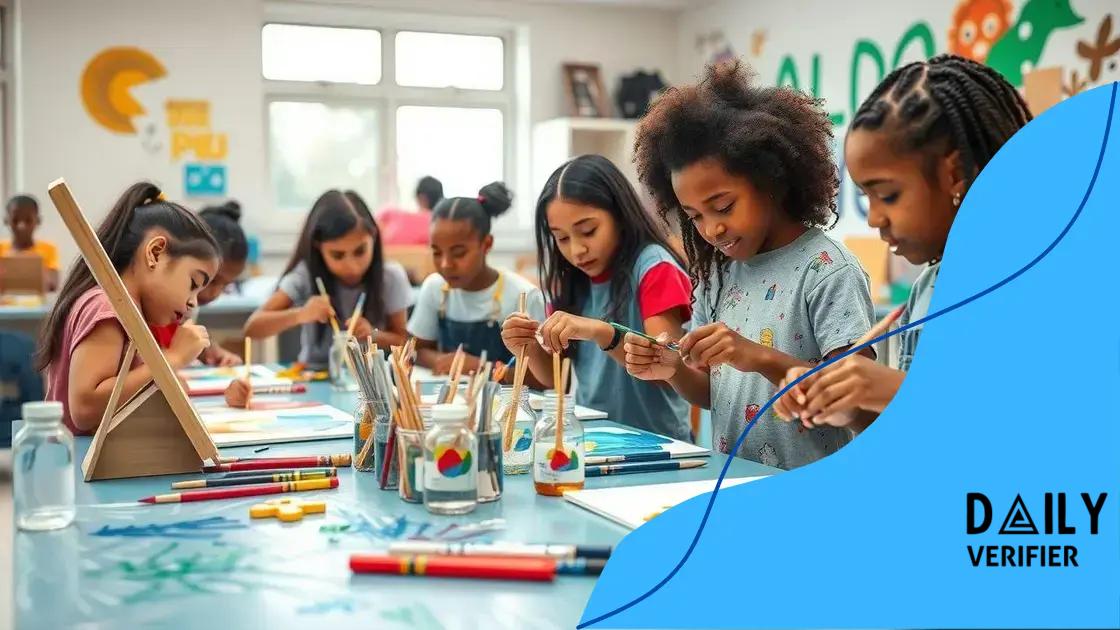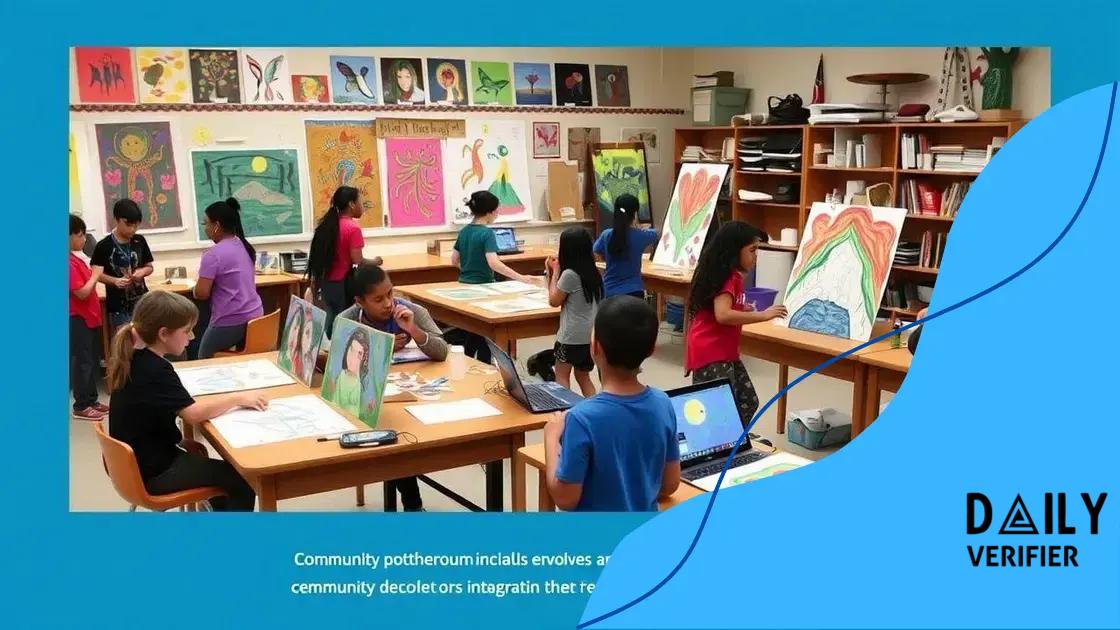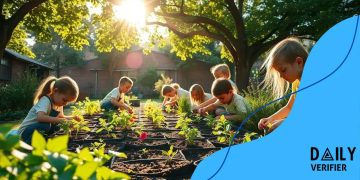Art programs return to schools: enriching student creativity

Art programs return to schools to enhance student creativity, improve academic performance, and foster emotional well-being, while community support and innovative funding are essential for their revival and sustainability.
Art programs return to schools with a resurgence that’s providing invaluable opportunities for students. Ever thought about how creativity shapes learning? Let’s explore this intriguing shift.
The importance of art education in schools
Art education plays a crucial role in shaping students’ lives. Art programs in schools not only enhance creativity but also develop essential skills that serve students throughout their lives. It’s fascinating to explore how these programs can ignite passion and interest in young learners.
Benefits of Art Education
Art education brings numerous benefits that are vital for personal and academic growth. By participating in art, students can:
- Enhance their critical thinking and problem-solving skills.
- Improve their communication abilities through visual expression.
- Boost their self-esteem and confidence as they create and share their work.
- Foster teamwork and collaboration in group projects.
Effective art programs also encourage cultural awareness. When students engage with various art forms, they gain insight into different cultures and perspectives. This broadens their understanding of the world and promotes inclusivity.
Another significant aspect is how art education complements academic subjects. For instance, learning about colors and shapes can enhance mathematical understanding. Engaging with stories in visual art improves literacy and storytelling skills. The interconnectedness of art with other subjects makes it an integral part of the educational experience.
Moreover, art fosters emotional expression and helps students manage their feelings. This emotional literacy is essential for mental well-being, especially in today’s fast-paced environment. With a safe space to express themselves, students are more likely to feel supported and understood.
In many schools, budget cuts have threatened art programs, but communities and educators are advocating for their restoration. Parents and teachers recognize that having art education is vital for nurturing well-rounded individuals. By revitalizing these programs, schools can ensure that students benefit from a comprehensive education that values creativity and innovation.
Every brushstroke, every color choice, and every artistic decision contributes to developing a student’s personality, skills, and emotional intelligence. Art education should not be seen as an auxiliary program, but rather as a core part of the learning journey.
Benefits of art programs for student development
Art programs provide numerous benefits that significantly enhance student development. By participating in these programs, students engage their creativity and imagination, which are essential skills in today’s world. It is exciting to see how art education influences academic performance and personal growth.
Key Advantages of Art Programs
Art programs contribute to student development in various ways:
- They boost critical thinking skills, allowing students to approach problems from different angles.
- The hands-on experience enhances motor skills and coordination.
- Students learn to express their emotions and ideas through various art forms.
- Collaboration in projects fosters teamwork and communication skills.
Many studies show a strong correlation between participation in art programs and improved academic performance. For instance, students involved in visual arts often excel in math and literacy because they develop skills in visualizing concepts and thinking abstractly. This interconnectedness makes art an invaluable part of education.
Integrated art education also encourages cultural awareness and appreciation. Students expose themselves to various art forms while learning about their origins and the stories behind them. This not only enriches their knowledge but also builds empathy and understanding of diverse perspectives.
Furthermore, art programs provide a safe space for self-expression. Students are allowed to explore their identities and values through creative outlets. This support contributes to their emotional intelligence, making it easier for them to navigate challenges. The confidence gained from sharing their art can have lasting effects on their personal and social lives.
Art education finally promotes discipline and responsibility as students learn to manage their time and resources while working on projects. The skills learned here are transferable to other subjects and to life beyond the classroom. Overall, the impact of art programs on student development is profound, making a strong case for their reinstatement in school curriculums.
How schools are reintegrating art programs
 Many schools are taking significant steps to reintegrate art programs back into their curriculums. This revitalization acknowledges the importance of art education, recognizing its positive impacts on student creativity and overall learning. As communities rally around this cause, schools are finding innovative ways to bring art back to life.
Many schools are taking significant steps to reintegrate art programs back into their curriculums. This revitalization acknowledges the importance of art education, recognizing its positive impacts on student creativity and overall learning. As communities rally around this cause, schools are finding innovative ways to bring art back to life.
Community Involvement
One effective method schools use involves engaging the community. Local artists and organizations are often invited to collaborate. This collaboration can lead to programs such as:
- After-school art clubs that allow students to explore their creative interests.
- Workshops led by professional artists who inspire and teach students new techniques.
- Art shows that display student work, fostering pride and support from families and friends.
In many cases, partnerships with local art galleries and museums enhance educational opportunities. These partnerships provide students with real-world experiences and exposure to various artistic styles. As a result, students can gain insights that enrich their artistic understanding.
Schools are also adapting their space to accommodate art. They are creating designated art rooms, which not only provides the right environment for creativity but also encourages students to fully engage in their projects. Furthermore, integrating technology into art programs, such as using digital media, allows students to explore contemporary forms of artistic expression.
For some schools, funding issues are a hurdle. However, initiatives like crowdfunding and grants have emerged. Administrators and teachers actively seek financial support to sustain art programs. They highlight the value of art education in their proposals, emphasizing how these programs can lead to improved student outcomes.
Another trend is the incorporation of art into other subjects. By blending art education with science, history, or literature, schools are creating interdisciplinary projects that enrich the learning experience. For example, students might illustrate a historical event or create models based on scientific principles, linking creativity with critical educational content.
Through these efforts, schools are making strides toward a future where art education is cherished and seen as vital. The resurgence of art programs contributes not just to individual achievements but fosters a culture of creativity in the learning environment.
Challenges faced in restoring art programs
Restoring art programs in schools comes with significant challenges that need to be addressed. These hurdles can hinder the successful implementation and sustainability of art education. Understanding these obstacles is critical for parents, teachers, and community members who advocate for the arts.
Budget Cuts and Funding Issues
One of the primary challenges is budget cuts. Many schools face financial constraints that make it difficult to allocate funds for art programs. Faced with competing priorities such as standardized testing and core subjects, administrators often view the arts as expendable. To combat this, schools must find innovative funding solutions.
- Applying for grants from arts organizations and community foundations.
- Creating crowdfunding campaigns to gather local support.
- Partnering with local businesses for sponsorship and funding opportunities.
- Engaging alumni and parents to contribute financially to the arts.
These strategies can help secure essential funding, but they require time and effort from educators and advocates.
Another challenge lies in the lack of trained art teachers. Many public schools have experienced a decline in staff members with proper qualifications to teach art. This shortage creates further difficulties in providing high-quality instruction. When schools attempt to restore art programs, they may have to focus on hiring qualified teachers or providing professional development to existing staff. Additionally, retrofitting existing spaces for art can be complex and costly.
Diverse student needs also create challenges. In many classrooms, students come from various backgrounds, with differing levels of exposure to art. To ensure all students benefit from art education, programs need to be inclusive and cater to different interests and skill levels. This requires thoughtful curriculum development and resources that can accommodate all learners.
Furthermore, societal perceptions around art programs can pose a significant hurdle. Some view art education as less important than traditional academic subjects. To change this perspective, advocates must demonstrate the benefits of art in fostering creativity, critical thinking, and collaboration. Raising awareness of how these skills contribute to future success is essential.
Despite these challenges, restoring art programs is possible with collective effort and determination. By addressing budget concerns, staffing needs, and changing societal views, schools can revitalize their art offerings, consequently enriching the education system as a whole. This journey requires commitment from the entire community.
Success stories from schools that revived art
Many schools across the country have successfully revived their art programs, demonstrating the profound impact these initiatives can have on students and communities. These success stories showcase how restoring art education not only enhances student creativity but also fosters a richer learning environment.
Case Study: Lincoln High School
Lincoln High School faced significant challenges when they had to cut their art program due to budget constraints. However, with the support of the community and local artists, the school managed to reinstate its art classes. This revival included:
- Conducting fundraising events that engaged local businesses and parents.
- Offering workshops led by local artists to inspire students and provide professional development for teachers.
- Creating an annual art exhibition that showcased student work and fostered community pride.
As a result, students reported higher levels of creativity and engagement in their overall studies. Increased participation also led to improved team-building skills as students collaborated on projects.
Example: Greenfield Elementary
Greenfield Elementary is another shining example of a school that reinstated its art program with great success. They focused on integrating art across the curriculum, combining subjects such as science and history with creative projects. Students engaged in activities like creating historical dioramas or designing science experiments. This approach not only enhanced their understanding of both subjects but also made learning enjoyable and meaningful.
The benefits were clear. Fresh enthusiasm for learning spread throughout the school, with many more students participating in class discussions and showing interest in their studies. Parents and teachers noticed a change as well, with students becoming more confident in their abilities.
In both schools, the importance of community involvement emerged as a critical factor. Residents saw firsthand how art education can transform students’ lives, and they rallied around these programs, securing ongoing support. Furthermore, these success stories highlight that reinstating art programs is not just about creativity; it is about encouraging well-rounded education that prepares students for the future.
As schools continue to share their success in reviving art, they inspire others to follow suit. Through innovative programs and community collaboration, the future of art education looks promising and bright for the next generation.
FAQ – Frequently Asked Questions about Art Programs in Schools
Why are art programs important in schools?
Art programs are crucial as they foster creativity, enhance critical thinking, and improve overall academic performance among students.
How can communities support art programs in schools?
Communities can support art programs by volunteering, donating supplies, and participating in fundraising events to ensure these programs have the necessary resources.
What are some common challenges in restoring art programs?
Common challenges include budget cuts, lack of trained art teachers, and societal views that prioritize core subjects over arts education.
Can integrating art into other subjects help improve education?
Yes, integrating art with subjects like science and history enhances understanding and creates a more engaging learning experience for students.






